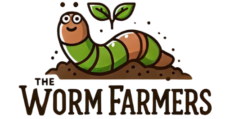Are you thinking about how to start worm composting but not sure where to begin? Don’t worry—you’re not alone. Every worm composting enthusiast starts somewhere, usually with a bag of confused worms and a whole lot of questions. Lucky for you, this guide is here to simplify everything and help you build the worm-powered composting setup of your dreams!
What Is Worm Composting?
Worm composting, or vermicomposting, is a natural process where worms eat your food scraps and turn them into nutrient-rich compost. Think of it as your very own recycling plant—but with worms as your employees.

Why You Should Learn How To Start Worm Composting?
If you need convincing, here’s why worm composting is amazing:
- Reduce Waste: Turn kitchen scraps into garden gold.
- Save Money: Free compost? Yes, please!
- Eco-Friendly: Reduce your carbon footprint and keep food waste out of landfills.
Plus, there’s something satisfying about knowing your trash is feeding your garden—and not a landfill.
Step-by-Step Guide to Starting Worm Composting
Step 1: Choose the Right Worms
Not all worms are created equal. For composting, red wigglers (Eisenia fetida) are the gold standard. Why? Because they:
- Thrive in organic waste.
- Reproduce quickly.
- Are voracious eaters (half their body weight daily!).
Step 2: Pick a Worm Bin
You’ll need a cozy home for your worms. Your options include:
- Store-Bought Bins: Perfect for beginners. Check out Best Worm Composting Bins for Beginners.
- DIY Bins: Great if you’re on a budget. Learn How to Build a DIY Worm Bin.

Make sure your bin:
- Is dark (worms hate light).
- Has ventilation holes for airflow.
- Has drainage holes to prevent waterlogging.
Step 3: Add Bedding
Think of bedding as your worms’ mattress—it needs to be comfy. Use:
- Shredded newspaper or cardboard. My favorite is the VermiFusion worm bedding blend by Meme’s worms. You can get it Here!
- Coconut coir. Get it Here!
- A handful of garden soil (for grit).
Pro Tip: Moisten the bedding so it’s damp but not soggy. Worms don’t swim!
Step 4: Introduce the Worms
Gently place your red wigglers into the bin. Let them settle in for a day or two before feeding them.

Step 5: Feed Your Worms
Start small with food scraps. Worms love:
- Fruit and veggie scraps.
- Coffee grounds.
- Eggshells.
Avoid:
- Citrus (too acidic).
- Meat and dairy (stinky and pest-attracting).
Want more details? Read What You Can and Can’t Compost in a Worm Bin.
Step 6: Maintain Your Worm Composting Bin
- Keep the bin between 55–77°F (13–25°C).
- Fluff the bedding occasionally to improve aeration.
- Monitor moisture levels (remember: damp, not soggy).
Common Beginner Mistakes (and How to Avoid Them)
- Overfeeding Worms: Worms are tiny—they can’t eat a mountain of scraps overnight. Start small and add more as needed.
- Ignoring Moisture Levels: Too dry? Worms will dehydrate. Too wet? They’ll drown. Keep bedding like a wrung-out sponge.
- Bin Smells Bad: Probably overfeeding or poor aeration. Read How to Fix a Stinky Worm Bin for help.
Harvesting Worm Compost
After a few months, you’ll notice rich, dark compost in your bin. Harvest it by:
- Moving the bedding and castings to one side.
- Adding fresh bedding and food to the empty side.
- Waiting a week for worms to migrate before collecting the compost.

FAQs About Starting Worm Composting
Q: How many worms do I need to start?
About 1 pound (approximately 1,000 worms) is a good starting point.
Q: Can I keep the bin indoors?
Absolutely! Worm bins are odor-free when maintained properly, so you can keep them in a kitchen, basement, or even a closet.
Q: How fast do worms process food?
Worms can eat half their body weight in food daily. So, 1 pound of worms = 0.5 pounds of food per day.
More Worm Composting Links
- Learn about Best Worms for Composting.
- Discover 5 Easy Ways to Use Vermicompost in Your Garden.
- Ready to troubleshoot? Read Troubleshooting Common Worm Bin Problems.
Final Thoughts
Starting worm composting is simple, fun, and incredibly rewarding. Not only will you reduce waste and help the environment, but your plants will thrive with the nutrient-rich compost your worms create. So grab some worms, a bin, and your food scraps—it’s time to get started!
If you have questions along the way, check out our Worm Composting FAQs or drop a comment below. Happy composting!





